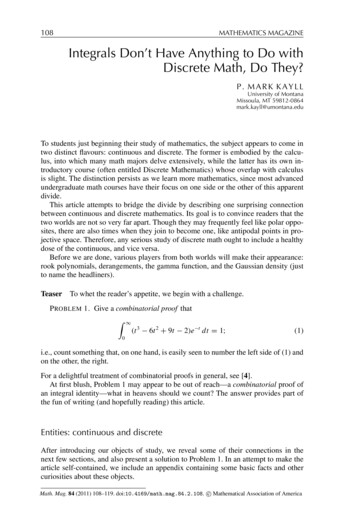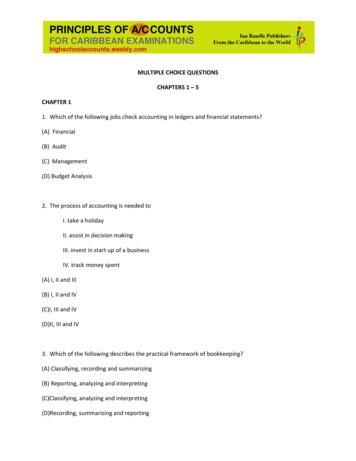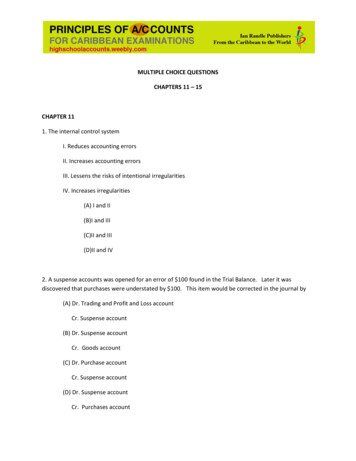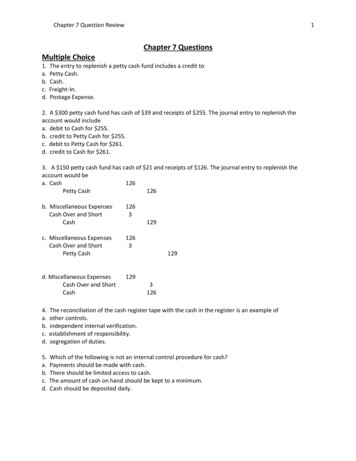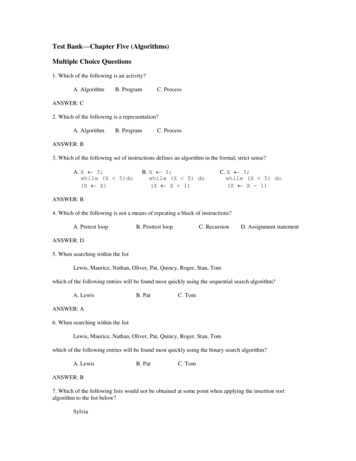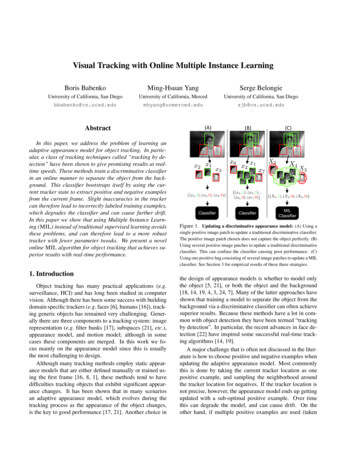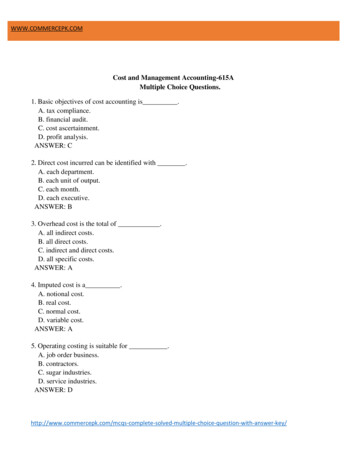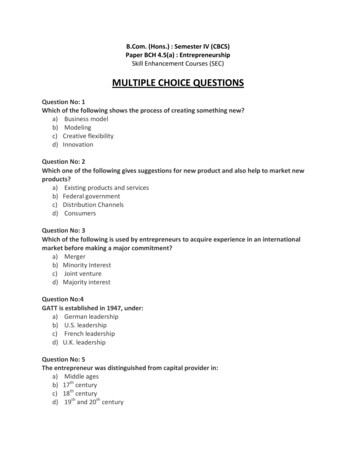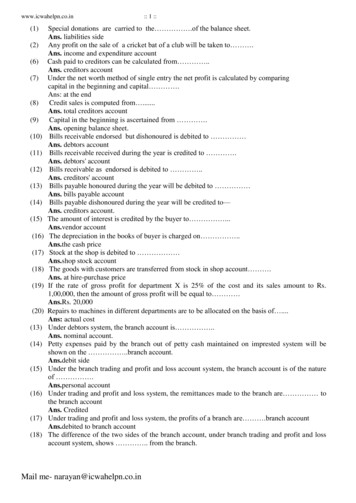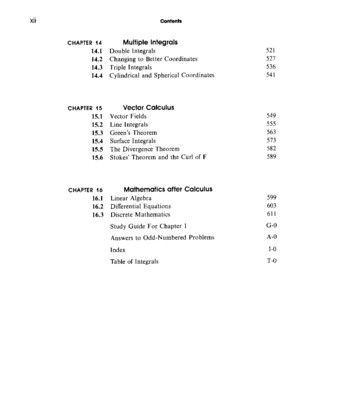
Transcription
ContentsCHAPTER 1414.114.214.314.4CHAPTER 1515.115.215.315.415.515.6CHAPTER 16Multiple IntegralsDouble IntegralsChanging to Better CoordinatesTriple IntegralsCylindrical and Spherical CoordinatesVector CalculusVector FieldsLine IntegralsGreen's TheoremSurface IntegralsThe Divergence TheoremStokes' Theorem and the Curl of FMathematics after Calculus16.1 Linear Algebra16.2 Differential Equations16.3 Discrete MathematicsStudy Guide For Chapter 1Answers to Odd-Numbered ProblemsIndexTable of Integrals
C H A P T E R 14Multiple Integrals14.1 Double Integrals4This chapter shows how to integrate functions of two or more variables. First, adouble integral is defined as the limit of sums. Second, we find a fast way to computeit. The key idea is to replace a double integral by two ordinary "single" integrals.The double integral f(x, y)dy dx starts with 1f(x, y)dy. For each fixed x we integrate with respect to y. The answer depends on x. Now integrate again, this time withrespect to x. The limits of integration need care and attention! Frequently those limitson y and x are the hardest part.Why bother with sums and limits in the first place? Two reasons. There has to bea definition and a computation to fall back on, when the single integrals are difficultor impossible. And also-this we emphasize-multiple integrals represent more thanarea and volume. Those words and the pictures that go with them are the easiest tounderstand. You can almost see the volume as a "sum of slices" or a "double sum ofthin sticks." The true applications are mostly to other things, but the central idea isalways the same: Add up small pieces and take limits.We begin with the area of R and the volume of by double integrals.SfA LIMIT OF SUMSThe graph of z f(x, y) is a curved surface above the xy plane. At the point (x, y) inthe plane, the height of the surface is z. (The surface is above the xy plane only whenz is positive. Volumes below the plane come with minus signs, like areas below thex axis.) We begin by choosing a positive function-for example z 1 x2 y2.The base of our solid is a region R in the xy plane. That region will be choppedinto small rectangles (sides Ax and Ay). When R itself is the rectangle 0 d x 1,0 y 2, the small pieces fit perfectly. For a triangle or a circle, the rectangles misspart of R. But they do fit in the limit, and any region with a piecewise smoothboundary will be acceptable.Question What is the volume above R and below the graph of z Ax, y)?Answer It is a double integral-the integral of f(x, y) over R. To reach it we beginwith a sum, as suggested by Figure 14.1.
14 Multiple Integralsarea AAFig. 14.1 Base R cut into small pieces AA. Solid V cut into thin sticks AV z A A.For single integrals, the interval [a, b] is divided into short pieces of length Ax.For double integrals, R is divided into small rectangles of area AA (Ax)(Ay). Abovethe ith rectangle is a "thin stick" with small volume. That volume is the base areaAA times the height above it-except that this height z f(x, y) varies from point topoint. Therefore we select a point (xi, y,) in the ith rectangle, and compute the volumefrom the height above that point:volume of one stick f(xi, yi)AAvolume of all sticks 1f(xi, yi)AA.This is the crucial step for any integral-to see it as a sum of small pieces.Now take limits: Ax - 0 and Ay 0. The height z f(x, y) is nearly constant overeach rectangle. (We assume that f is a continuous function.) The sum approaches alimit, which depends only on the base R and the surface above it. The limit is thevolume of the solid, and it is the double integral of f(x, y) over R:- J JRf(x, y) dA lim1f(xi, yi)AA.A x -t 0Ay OTo repeat: The limit is the same for all choices of the rectangles and the points (xi, yi).The rectangles will not fit exactly into R, if that base area is curved. The heights arenot exact, if the surface z f(x, y) is also curved. But the errors on the sides and top,where the pieces don't fit and the heights are wrong, approach zero. Those errors arethe volume of the "icing" around the solid, which gets thinner as Ax - 0 and Ay - 0.A careful proof takes more space than we are willing to give. But the properties ofthe integral need and deserve attention:1. Linearity: jj(f g)dA jj f d j j g dA2. Constant comes outside: jj cf(x, y)dA c jj f(x, y)dA3. R splits into S and T(not overlapping): ]j f d jj f d jj f d .RSTIn 1 the volume under f g has two parts. The "thin sticks" of height f g split intothin sticks under f and under g. In 2 the whole volume is stretched upward by c. In3 the volumes are side by side. As with single integrals, these properties help incomputations.By writing dA, we allow shapes other than rectangles. Polar coordinates have anextra factor r in dA r dr do. By writing dx dy, we choose rectangular coordinatesand prepare for the splitting that comes now.
14.1Double Integrals523SPLITTING A DOUBLE INTEGRAL INTO TWO SINGLE INTEGRALSThe double integral JSf(x, y)dy dx will now be reduced to single integrals in y andthen x. (Or vice versa. Our first integral could equally well be ff(x, y)dx.) Chapter 8described the same idea for solids of revolution. First came the area of a slice, whichis a single integral. Then came a second integral to add up the slices. For solidsformed by revolving a curve, all slices are circular disks-now we expect other shapes.Figure 14.2 shows a slice of area A(x). It cuts through the solid at a fixed value ofx. The cut starts at y c on one side of R, and ends at y d on the other side. Thisparticular example goes from y 0 to y 2 (R is a rectangle). The area of a slice isthe y integral of f(x, y). Remember that x is fixed and y goes from c to d:A(x) area of slice EXAMPLE 1 A f(x, y)dy(the answer is a function of x).(1 x2 y2)dy [y x2y -13y 0 O 22x2832This is the reverse of a partial derivative! The integral of x dy, with x constant, isx 2y. This "partial integral" is actually called an inner integral.After substituting thelimits y 2 and y 0 and subtracting, we have the area A(x) 2 2x 2 1. Now theouter integraladds slices to find the volume f A(x) dx. The answer is a number:381'2 8 16[2xdx 2x 8x 2 - 8-S8) 22 x2 volume 33333 3 oz1-----7:.nelgntf(x, y)IIIIII IIIIfix.IIIinII 1\IIIIIIIIIIIIix yxxFig. 14.2 A slice of V at a fixed x has area A(x) ff(x, y)dy.To complete this example, check the volume when the x integral comes first:(1 xinner integral y2)dx x xy2outer integralS4- 3x 0 y2 dy 31x 0y28y 1-y3]Y 2 83 3 Y O8 231633 3 16The fact that double integrals can be split into single integrals is Fubini's Theorem.14A Iff(x, y) is continuous on the rectangle R, thenSf(x,y)dA [f(x, y)dy dx d[bf(x, y)dx dy.(2)
52414 Multiple IntegralsThe inner integrals are the cross-sectional areas A(x) and a(y) of the slices. The outerintegrals add up the volumes A(x)dx and a(y)dy. Notice the reversing of limits.Normally the brackets in (2) are omitted. When the y integral is first, dy is writteninside dx. The limits on y are inside too. I strongly recommend that you compute theinner integral on one line and the outer integral on a separate line.EXAMPLE 2triangle R.Find the volume below the plane z x - 2y and above the baseThe triangle R has sides on the x and y axes and the line x y 1. The strips in they direction have varying lengths. (So do the strips in the x direction.) This is the mainpoint of the example-the base is not a rectangle. The upper limit on the innerintegral changes as x changes. The top of the triangle is at y 1 - x.Figure 14.3 shows the strips. The region should always be drawn (except forrectangles). Without a figure the limits are hard to find. A sketch of R makes it easy:y goes from c 0 to d 1 - x. Then x goes from a 0 to b 1.The inner integral has variable limits and the outer integral has constant limits:inner:Y- X)(1 - ) 2x(x - 2y)dy [xy y2-1 3x -2x2y 0outer:x o3 2 2 (- 3x - 2x2)dx - x x3233231o223116The volume is negative. Most of the solid is below the xy plane. To check the answer- 6, do the x integral first: x goes from 0 to 1 - y. Then y goes from 0 to 1.inner:-Y(x 12y)dx I[x2- 2xy51-Y 2(11-1- 23(53261y) - 2(1 - y)y -o3y 13512266522Same answer, very probably right. The next example computes ff 1 dx dy area of R.EXAMPLE 3 The area of R isdy dx and alsox 0dx dy.y 0y 0x 0The first has vertical strips. The inner integral equals 1 - x. Then the outer integral(of 1 - x) has limits 0 and 1, and the area is ½. It is like an indefinite integral insidea definite integral.y 4y 43y lx201Yx1r 2Fig. 14.3 Thin sticks above and below (Example 2). Reversed order (Examples 3 and 4).
14.1 Double IntegralsEXAMPLE 4Reverse the order of integration inSolution Draw a figure! The inner integral goes from the parabola y x2 up tothe straight line y 2x. This gives vertical strips. The strips sit side by side betweenx 0 and x 2. They stop where 2x equals x2, and the line meets the parabola.The problem is to put the x integral first. It goes along horizontal strips. On eachline y constant, we need the entry value of x and the exit value of x. From the figure,Those are the inner limits. Pay attention also to the outerx goes from )y tolimits, because they now apply to y. The region starts at y 0 and ends at y 4.No charlge in the integrand x3-that is the height of the solid:&.x3dy dx is reversed to(3)EXAMPLE 5 Find the volume bounded by the planes x 0, y 0, z 0, and2x y 4-z 4. Solutiorr The solid is a tetrahedron (four sides). It goes from z 0 (the xy plane) upto the plane 2x y z 4. On that plane z 4 - 2x - y. This is the height functionf(x, y) to be integrated.Figure 14.4 shows the base R. To find its sides, set z 0. The sides of R are thelines x 0 and y 0 and 2x y 4. Taking vertical strips, dy is inner: 1,S' 4-2xinner:outer: o1Questbn What is the meaning of the inner integral -(4 - 2 ) 216Answer The first is A(x), the area of the slice. - is the solid volume.3Question What if the inner integral f(x, y)dy has limits that depend on y?Answer It can't. Those limits must be wrong. Find them again.density p yFig. 114.4 Tetrahedron in Example 5, semicircle in Example 6, triangle in Example 7.EXAMPLE 6 Find the mass in a semicircle 0 y ,/I-x2 if the density is p y.This is a. new application of double integrals. The total mass is a sum of small masses(p times AA) in rectangles of area AA. The rectangles don't fit perfectly inside thesemicircle R, and the density is not constant in each rectangle-but those problems
14 Multiple Integralsdisappear in the limit. We are left with a double integral:Set p y. Figure 14.4 shows the limits on x and y (try both d y d x and d x dy):Iyz0jJF?massM jlx -1ydydxandalsoV'FjiM I1ydxdy.y o -Ji--; The first inner integral is iy2.Substituting the limits gives g 1 -- x2). The outer integralof (1 - x 2 ) yields the total mass M 3. ThenThe second inner integral is x y . Substituting the limits on x gives.the outer integral is - (I - y2)312.Substituting y 1 and y 0 yields M Remark This same calculation also produces the moment around the x axis, whenthe density is p 1. The factor y is the distance to the x axis. The moment is M x y d A Dividing by the area of the semicircle (which is 4 2 ) locates the centroid:2 0 by symmetry andmoment - 213 - 4y height of centroid -- - - (5)area7112 37 '5.This is the "average height" of points inside the semicircle, found earlier in 8.5.EXAMPLE 7Integrate1;: 1::cos x 2 d x d y avoiding the impossible cos x 2 d x .This is a famous example where reversing the order makes the calculation possible.The base R is the triangle in Figure 14.4 (note that x goes from y to 1). In the oppositeorder y goes from 0 to x. Then cos x 2 d y x cos x2 contains the factor x that weneed:Iouter integral: x cos x 2 d x [f sin x2]A sin 1.014.1 EXERCISESRead-through questions--The double integral IS, f ( x , y)dA gives the volume between Rand a . The base is first cut into small b of area A A.The volume above the ith piece is approximately c . Thelimit of the sum d is the volume integral. Three propertiesof double integrals aree(linearity) andfand9.If R is the rectangle 0 x 4 , 4 y 6, the integral Sf x dAcan be computed two ways. One is SSx dy dx, when theinner integral is h 1: i . h outer integral givesI 1; k . When the x integral comes first it equalsl x dx I 1, m . Then the y integral equalsn . This is the volume betweeno(describe V).The area of R is jl P dy dx. When R is the trianglebetween x 0, y 2x, and y 1, the inner limits on y ares . This is the length of a r strip. The (outer) limitson x are s . The area is t . In the opposite order, the(inner) limits on x are u . Now the strip is v and theouter integral is w . When the density is p(x, y), the totalmass in the region R is SS x . The moments are M y Yand M x z . The centroid has 2 M,/M.Compute the double integrals 1-4 by two integrations.2c2' jey 2j1 jx:r 2 d i dy and2xy dx dy andx land4jolj:y2dx dyPOyexydx dy andj:1j121; dy d x / ( x y)l
52714.2 Change to Better CoordinatesIn 5-10, draw the region and compute the area.30 Find the limits and the area under y 1 - x2:(1 - x2)dx and1l 1 dx dy (reversed from 29).31 A city inside the circle x2y2 100 has population density p(x, y) 10(100- x2 - y2). Integrate to find its population.32 Find the volume bounded by the planes x 0, y 0,z 0 , and a x by cz 1.In 11-16 reverse the order of integration (and find the newlimits) in 5-10 respectively.In 17-24 find the limits oncompute its area.II dy dx and Jjdx dy. Draw R and17 R triangle inside the lines x 0, y 1, y 2x.18 R triangle inside the lines x - 1, y 0, x y 0.In 33-34 the rectangle with corners (1, I), (1, 3), (2, I), (2, 3) hasdensity p(x, y) x2. The moments are M y Jlxp dA andMx YP dA34 Find the center of mass.33 Find the mass.IIIn 35-36 the regio
Reversed order (Examples 3 and 4). 14.1 Double Integrals EXAMPLE 4 Reverse the order of integration in Solution Draw a figure! The inner integral goes from the parabola y x2 up to the straight line y 2x. This gives vertical strips. The strips sit side by side between x 0 .
